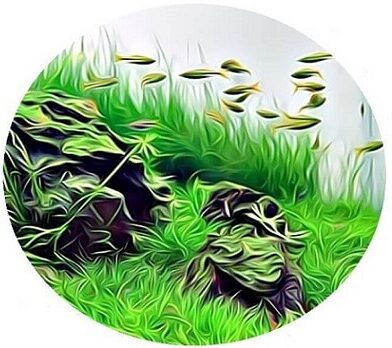Step-by-Step – How To Setup a Low Tech Aquarium
The Low Tech Planted Aquarium
There is a lot of talk about low tech planted aquarium and how to setup them.
Do I need to have fertile substrate? Some special soil for aquariums?
Which are the low tech aquarium plants that I can use? Do I need a CO2 cylinder?
Special and Strong light? What fertilizer for a low tech planted aquarium?
The truth is one can for sure have an aquarium with several plants and not need any of that.
It is the so-called Low Tech Planted Aquarium.
If your focus is on the fish, and the plants are just there to beautify and make the environment more stable and healthy, you can think about having an aquarium with plants or a low tech planted aquarium.
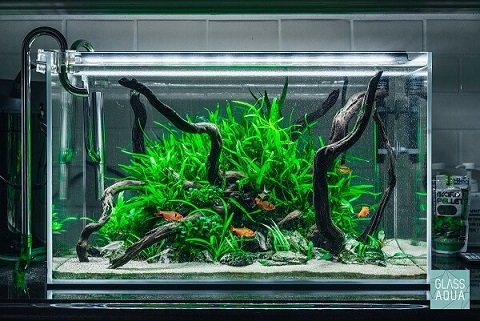
If your goal is to have an aquarium with vast flora made up of demanding species and a carpet covering practically the entire aquarium, you will want a high-tech planted aquarium.
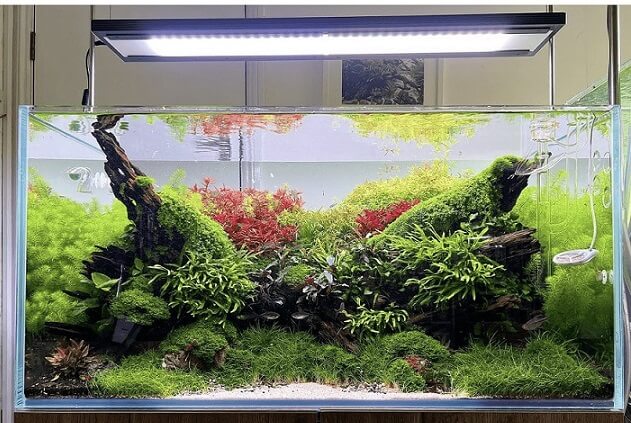
In this article, I will explain what is necessary if you want to build a low-tech planted aquarium.
Table of Content
Step-by-Step – How To Setup your aquarium
Planning before
I prefer to plan the landscaping before setting it up.
I use paper and draw a drawing (a 40″ X 16″ aquarium is a 4″ X 1.5″ rectangle).
I distribute the flora, rocks, etc.
A 2″ between the plants is drawn as a point every 0.2″.
It gives an excellent idea of how the aquarium will look when assembled.
The Famous Golden Ratio
When creating an aquarium layout, you can use the golden ratio grid, the rule of thirds or the golden spiral to divide and define the spaces in your aquarium.
These methods will help you avoid strong symmetries that would make your aquarium look unnatural, artificial, or simply boring and static.
Read more about the Golden Ration here.
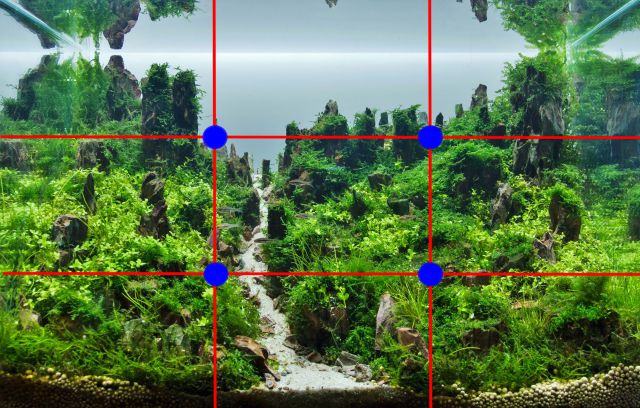
Soil & Substrate
Start from the front of your aquarium, making a bed of gravel/sand with 2″ , and gently go up until you reach 3″ or 4″ in the bottom.
Positioning your plants and rocks
If you use large stones or trunks, I like to start with them.
I place them where I want and add the substrate burying their bases.
Try to avoid blocking the water flow with these big rocks or trunks.
Plants:
- Taller plants in the back and shorter plants in the front.
- Avoid aligning plants in a perfect line if you want your aquarium to look very natural.
- Putting a plant a little to the right or left and a little to the front or back of another one will create a high or low perspective. Play with it.
- Research each plant and check if they are fast-growing or not. If they are, try not to plant them in the front of your tank.
- The middle of your tank will get stronger light. Consider this if you have plants with higher light necessity.
- Leave some space between the back plants and the glass so it will be easier for you to clean up the glass later.
Planting your plants
I prefer to plant the plants before filling the aquarium.
Use your fingers to “drill” the substrate at the chosen point and, place the root in it, cover it.
Check if everything is ok.
Take pictures! Now is the moment. You will be proud later !!! Your creation is coming to life.
Filling your aquarium with water and cycling
Start filling the aquarium with water.
I like using a plate at the bottom to receive and alleviate the water jet (or a hose with a showerhead at the end). Fill it up to the desired level.
Turn on the filter and leave it for about 30 days to cycle; this is important!
You must cycle your aquarium *before* putting fish!
Check this article to understand the “cycle your aquarium” process and learn how to speed up this process.
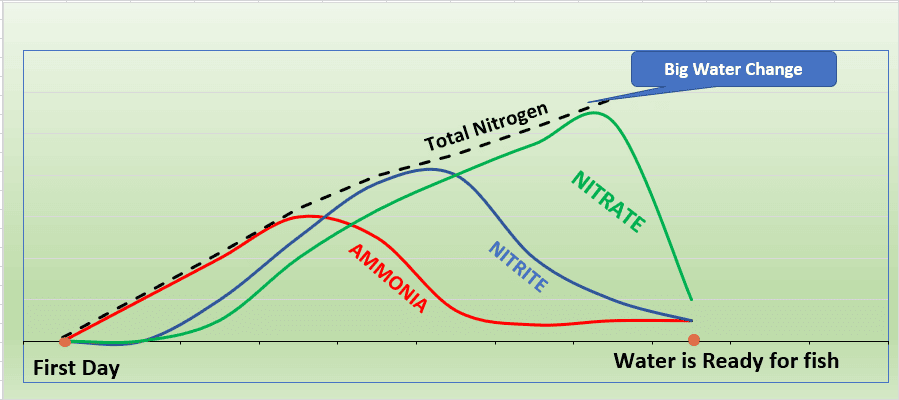
Appreciate your aquarium. Check it during the night. Change and adjust plants and rocks. Now is the right moment.
Take tons of pictures!
Look this article and understand how you know if your aquarium is cycled and ready to receive fish.
Learn more about ammonia, pH and other water parameters here.
Again, check this article to ensure everything is correct and you have good bacteria working on your filter and substrate. Learn about them here.
Before introducing the fish, I recommend a water change (we call TPA) of 30% to 50% to guarantee the healthiness of the environment.
Injected CO2. Is it necessary?
All plants (aquatic or not) need CO2 to produce energy in photosynthesis. That is how they will make energy for themselves (their food). Most low-tech aquarium plants will utilize about 2 to 4 ppm of CO2.
When the CO2 is not injected, it comes into the water naturally from:
- Surface gas exchange (yes, your aquarium water keeps exchanging gas with your room/environment seeking to reach an equilibrium of CO2, O2, and other gases)
- From fish and snails respiration
- From the plants themselves (due to the photosynthesis process during the night).
Several plants don’t need a high level of CO2, and they don’t demand injected CO2. They will grow more slowly, but they will not die in the absence of CO2.
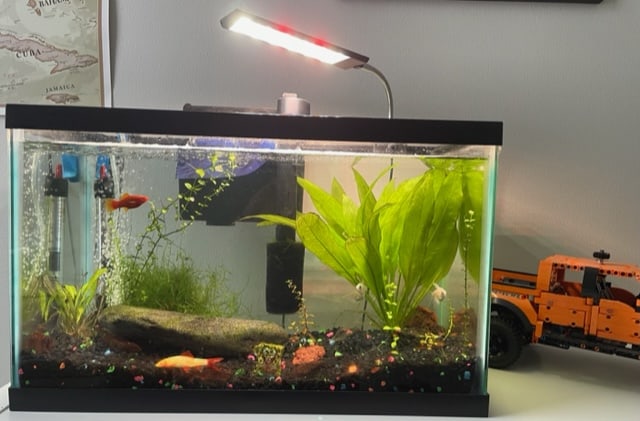
When the lights go on, plants will start to consume CO2 faster than it is produced, and its level will go down after some hours and until the lights go off again.
Learn more about injected CO2 here.
Siesta as a way to have more CO2
Some aquarists use the “siesta” process as a way to increase the CO2 level again. They reproduce two days and two nights during one actual day.
To have a good CO2 level, they turn off their lights in the middle of the day for, let’s say, 3 to 4 hours to cheat their plants into believing that it is already night, so they will produce CO2 again (and consume O2 – photosynthesis).
When they turn on the light again, for the second time in the day, the CO2 levels in the water will be high again.
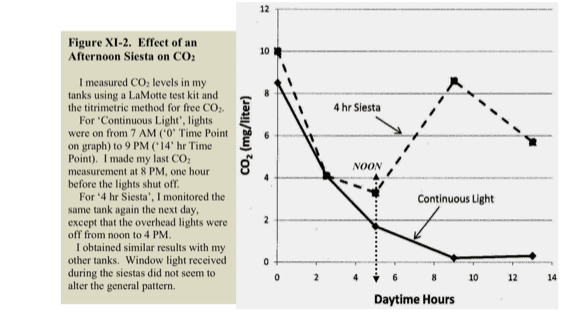
Diana Walstad Figure XI-2 Effect of an Afternoon Siesta on CO2. Credits to Diana at https://dianawalstad.com/
Diana Walstad Figure XI-2 Effect of an Afternoon Siesta on CO2 – Book “Ecology of the Planted Aquarium“
So, they turn on the light for about 4 hours, turn it off for about 3 hours and turn it on again for another 4 hours.
If you want to get into it, check this forum discussion from Aquarium-Coop, and special thanks to Mr. Streetwise for sharing his knowledge.
If you want to go even deeper, buy this book from Diana Walstad.
Another good source of information can be found here.
The substrate
A large number of plants do not necessarily need a fertile soil. Some, like Cabombas, Ceratophilum, Microsorum, Anubias, and mosses, don’t even need substrate and can be tied/anchored to stones or logs.
Remember that plants do not only consume nutrients through the root. They also use their leaves and trunk to absorb nutrients.
By the way, sand and some substrates (gravel 5mm), for example, do not prevent the liquid fertilizer from reaching the root, so the roots will consume nutrients sooner or later.
Another possible approach in the case you want to help your plants and give them a boost and accelerate their growth or if you want to have more demanding plants is to plant them in a pot filled with a fertile substrate or, sometimes, using liquid fertilizers or fertilize tabs.
This pot can be buried in sand or gravel and removed quickly and safely if necessary.
Lighting for a Low Tech Aquarium
The light component of your aquarium is crucial as it will help you see your fish, plants, and decoration and also help your plants grow.
Imagine a lovely aquarium with the lights turned off. Now imagine it with the lights turned on! Which one do you think will be more beautiful?
Beauty aside, plants need light to do their photosynthesis. They need light to produce their energy, like we need oxygen to breathe.
A large portion of the existing plants for aquariums can be maintained with lighting between 0.5 and 0.8 W/L.
You should start with 4 to 6 hours of light per day for some weeks (4 to 5 weeks).
Slowly increase 30 minutes per week later (too much light will cause algae).
Filtration
Your aquarium filtration process won’t change too much if you have plants in your tank, and your plants will not grow faster or better if you have a better filtration system.
The only correlation between filtration and plants is that a good water flow can better spread nutrients through the aquarium.
As usual, filters with a flow rate of 3 to 7 times (varying with the filter used) are indicated.
I suggest you to have a look on this article where I explain how a filter works, types of filter and which one I recommend.
Fertilization and maintenance:
Some plants may need supplemental fertilization. So, what fertilizer should I use for a low tech planted aquarium?
I recommend liquid fertilization explicitly made for aquariums.
This is my preferred one.
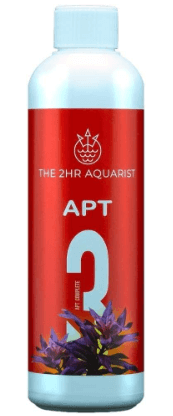
Low-Tech aquarium plants
If you want to see the TOP 13 Plants for your Low Tech aquarium, jump to this article.
Background plants
Alternanthera reineckii rosaefolia (gravel/pot – 0.8 w/l)
Anubia glabra (gravel – 0.5w/l)
Cabomba caroliniana (gravel/stone/trunk – 0.7w/l)
Ceratophyllum demersum (gravel/stone/trunk – 0.5w/l)
Ceratopteris cornuta (gravel/floating – 0.5w/l)
Dense Elodea (gravel/floating/stone/trunk – 0.5w/l)
Heteranthera zost
erifolia (gravel/pot – 0.6w/l)
Limnophila sessiliflora (gravel/pot – 0.7w/l)
Lysimachia nummularia (gravel/pot – 0.7w/l)
Myriophylum (gravel/pot – 0.7 w/l)
Najas conferta (gravel – 0.7w/l)
Najas indica (gravel – 0.7 w/l)
Nitella (gravel – 0.5w/l)
Nymphaea sp rubra (gravel/pot – 0.7 w/l)
Nymphoides cristata (gravel – 0.7w/l)
Rotala repens (gravel/pot – 0.7w/l)
Rotala rotundifolia (gravel/pot – 0.6w/l)
Utricularia – all (gravel – 0.7 to 1.0w/l)
Vallisnerias – all (gravel – 0.3 to 0.5w/l)
Medium plants
Bacopa monnieri (gravel – 0.6w/l)
Bolbitis heudelotii (stone/trunk – 0.3w/l)
Cryptocorynes in general (gravel/pot – 0.3 to 0.7 w/l)
Hemianthus micrantemoides (gravel/pot – 0.7 w/l)
Microsorum -all (stone/trunk – 0.3w/l)
Mosses (especially Java, stones/trunk – 0.3 to 7.0w/l)
Nymphoides aquatica (gravel – 0.5w/l)
Potamogeton sp. (gravel/pot – 0.7w/l)
Riccia Flutans (stone/trunk with CO2 or floating – 1.0 w/l)
Riccia stenophyla (stone/trunk with CO2 or floating – 1.0 w/l)
Rotala repens(gravel/pot – 0.7w/l)
Rotala rotundifolia (gravel/pot – 0.6w/l)
Front plans
Anubia barteri nana (stone/trunk – 0.3w/l)
Cryptocorynes in general (gravel/pot – 0.3 to 0.7 w/l)
Microsorum windelov (stone/trunk – 0.3w/l)
Mosses (especially Java, stones/trunk – 0.3 to 0.7 w/l)
Riccia Flutans (with CO2 stone/trunk/FBF plate or floating – 1.0w/l)
Riccia stenophyla (with CO2 stone/trunk/FBF plate or floating – 1.0w/l)
Sagittaria natans (gravel – 0.5 w/l)
Sagittaria subulata subulata (gravel – 0.5w/l)
Sagittaria subulata pusilla (gravel – 0.5w/l)
Sagittaria sp Bras (gravel – 0.5 w/l)
Carpets:
Echinodorus tenellus (gravel – 0.7w/l)
Mosses (especially Java moss and Fontinalis antipyretic, FBF stones/plates)
Sagittaria natans (but requires more seedlings)
Sagittaria subulata subulata (ditto)
Sagittaria subulata pusilla (ditto)
Sagittaria sp Bras (idem)
Floating
Ceratopteris (0.5w/l)
Duckweed (Lemna sp.) (0.5w/l)
Riccias (1.0w/l)
Salvinias (0.5w/l)
Fish for Planted Aquarium Suggestions
Recommended fish for planted aquariums are those that don’t feed on plants and don’t stir the substrate much because, if they keep stirring your substrate, your plants will loosen.
Some examples of fish that go very well in planted aquariums are, for example:
- All kinds of Tetras (Lemon Tetra, Cardinal Tetra, X-Ray Tetras, etc)
- All kinds of Angelfish
- Flying Fox Fish
- Rainbow Fish Species
- Guppy Fish
- Molly Fish Species
- Harlequin Rasboras
- Otocinclus Catfish
References
Diana Walstad has an amazing article called Planted Aquariums in her website – “Information about ‘Ecology of the Planted Aquarium’ plus articles by Diana Walstad on planted tanks, tropical fish diseases, and guppy breeding.”
Light in Planted Tanks from @Acinonyx and the Barr Report Website here.
Also in the Barr Report, there is a very good article from Jason King about Non CO2 Methods here.
Learn about the “Aquascaping with the golden ratio” from Aquasabi here.
